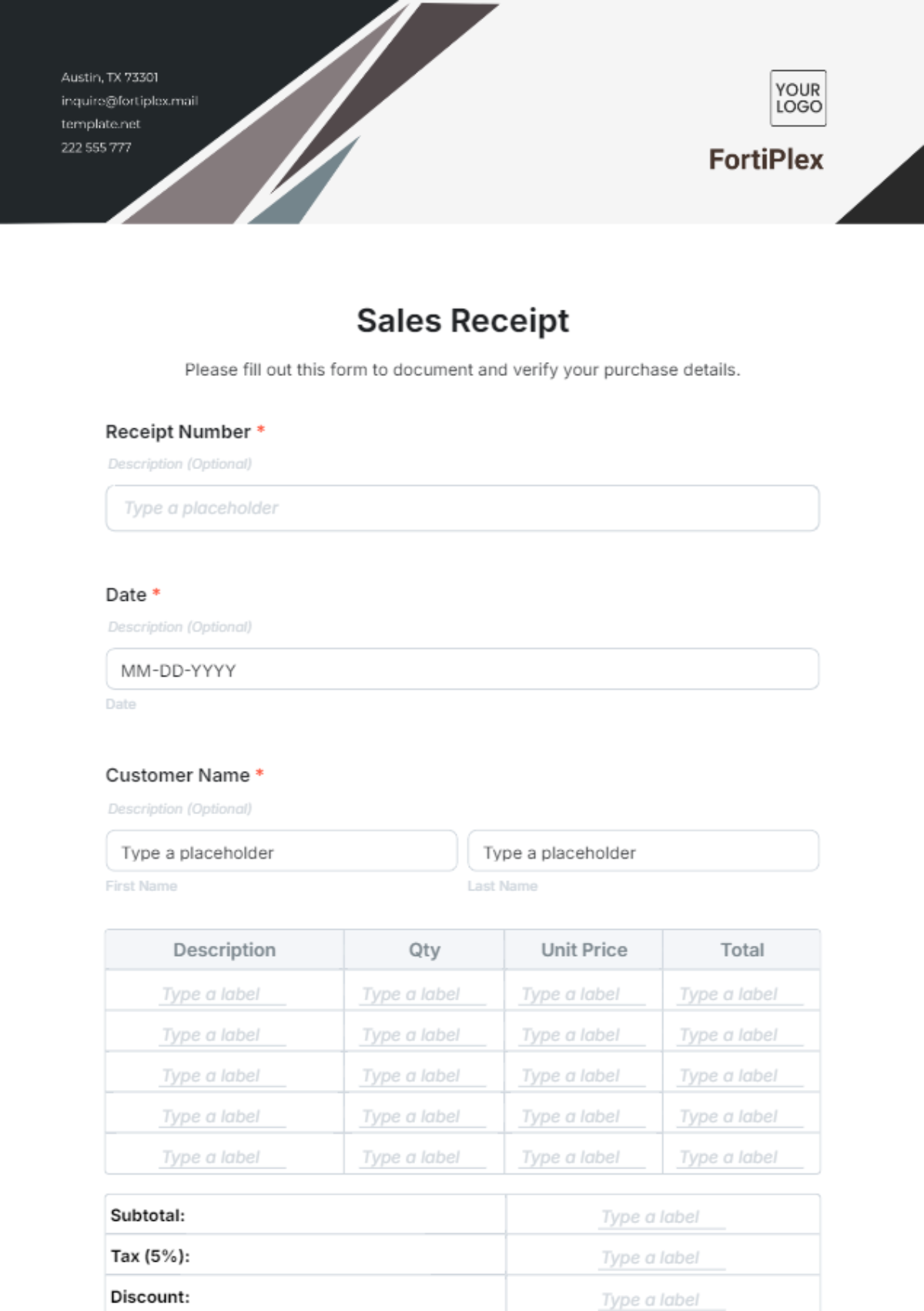Sales Study on Customer Behavior
Based on Data
I. Executive Summary
In this exhaustive study, we take a deep dive into the intricate landscape of customer behavior and scrutinize its multifaceted implications for sales at [Your Company Name]. Utilizing advanced data analytics techniques, we sift through a vast array of data points to provide a well-rounded and insightful portrayal of our customer base. This initiative isn't just an academic exercise; it's geared toward empowering our sales and marketing teams with actionable insights that can fuel better-informed, data-driven decision-making processes.
The scope of our investigation spans several key areas: from basic purchasing habits to complex behavioral influences dictated by demographic variables. Additionally, the study probes into customer loyalty patterns, attempting to decode what keeps our customers engaged and coming back for more. We also delve into customer journey mapping to identify potential touchpoints for increasing sales and improving the overall customer experience. By doing so, this study serves as a blueprint for enhancing both customer satisfaction and company profitability.
The implications of our findings are vast and varied, affecting everything from inventory management to marketing strategy. The culmination of this research offers not just observations but also actionable recommendations that aim to elevate customer interactions, thereby enhancing sales and fostering long-term relationships. Through this study, our ultimate objective is to systematically optimize the customer experience while boosting sales and operational efficiency at [Your Company Name].
II. Introduction
A. Background
In today's increasingly competitive marketplace, gaining a nuanced understanding of customer behavior is crucial for survival and growth. Customer behavior isn't just a subject of academic interest; it holds the keys to unlocking greater sales potential and customer retention for businesses. With the advent of big data and advanced analytics, we have the tools to dig deeper into customer choices, interactions, and patterns. This study leverages those technologies to provide a holistic view of the customer journey, offering actionable insights that can be instrumental in shaping [Your Company Name]'s sales strategies.
B. Objectives
The primary objectives of this study are twofold:
To systematically explore and analyze data related to customer behavior in various contexts such as online and in-store interactions, social media engagement, and other points of customer contact.
To distill these findings into actionable insights and concrete recommendations aimed at optimizing sales processes, refining marketing strategies, and enhancing customer satisfaction.
By achieving these objectives, we aim to equip [Your Company Name] with the knowledge required to adapt to changing consumer preferences and to keep up with, or even outpace, competitors in the market.
C. Scope
The scope of this research is broad yet focused, covering all recorded customer interactions and behaviors across various touchpoints within [Your Company Name]. This includes, but is not limited to, website visits, in-store interactions, customer reviews, social media activity, and any customer service communications. By examining these varied touchpoints, we can garner a 360-degree view of our customer base, enabling a more comprehensive understanding of their behavior and preferences. This wide-ranging scope ensures a more complete analysis, thereby enhancing the quality and applicability of our insights.
III. Methodology
In order to achieve a nuanced understanding of customer behavior, we employed a multi-pronged approach that combined both qualitative and quantitative research methods. This hybrid methodology allowed us to capture the depth and breadth of customer interactions and choices, thereby ensuring a more comprehensive data set for analysis.
Qualitative Methods
Surveys: Customer surveys were distributed both online and in-store to gather insights into customer preferences, pain points, and overall shopping experience.
Quantitative Methods
A/B Testing: This was primarily done on our website to evaluate the effectiveness of different sales strategies, web designs, and marketing messages.
Historical Sales Data Analysis: We examined past sales records to identify trends, peak sales periods, and customer buying patterns.
Table: Tools Utilized for Analysis
Tool | Purpose | Responsible Team |
R Programming | Statistical Analysis | Data Science Team |
Google Analytics | Web Behavior Analysis | Marketing Team |
Tableau | Data Visualization | Data Visualization Team |
R Programming: Our data science team used R for intricate statistical analyses including regression analysis, cluster analysis, and hypothesis testing to identify underlying patterns in customer behavior.
Google Analytics: Employed by the marketing team, Google Analytics provided crucial metrics about website visitors, bounce rates, and user engagement, thus enabling a deeper understanding of web-based customer behavior.
Tableau: Data visualization experts within the company used Tableau to create interactive dashboards and reports that made the data more interpretable, aiding in both internal understanding and presentation to stakeholders.
By utilizing these tools and methods in concert, we were able to not only gather a wealth of data but also translate it into actionable insights that [Your Company Name] can use to better understand its customer base and improve sales strategies.
IV. Data Sources
A robust study of customer behavior requires data from multiple channels to form a comprehensive view. The following data sources were meticulously chosen to suit the diverse needs of this study. Each source provides a distinct type of data that contributes to our overall understanding of customer behavior at [Your Company Name].
Table: Data Sources
Data Source | Description | Responsible Team/Individual |
CRM | Customer data | Sales Team |
Google Analytics | User interactions on website | Marketing Team |
Customer Surveys | Direct customer feedback | Customer Support |
CRM (Customer Relationship Management): Managed by the Sales Team, our CRM system is a treasure trove of customer data. It captures details like purchase history, interactions through calls and emails, and demographic information. This data helps us understand buying patterns and preferences on an individual and segmented basis.
Google Analytics: Operated by the Marketing Team, Google Analytics collects data related to how customers are interacting with our website. Metrics like page views, time spent on site, and conversion rates give us valuable insights into the digital behavior of our customer base. This is crucial for optimizing our online presence and understanding how online interactions contribute to overall customer behavior.
Customer Surveys: Administered by the Customer Support Team, these are direct lines to the customers' thoughts and opinions. These surveys collect feedback on product quality, customer service, and overall experience, providing an unfiltered view into what customers really think and want.
Each of these data sources contributes a unique piece to the puzzle, allowing us to form a 360-degree view of our customer behavior. This multi-faceted approach ensures that our findings are both robust and actionable.
V. Data Analysis
The data analysis phase is a critical step in our study, as it's where the raw data is transformed into actionable insights. We focused on a variety of metrics that provide a well-rounded understanding of customer behavior. These metrics not only illuminate the current state of our customer relations but also guide future strategy for [Your Company Name].
Table: Key Metrics Evaluated
Metric | Result | Interpretation |
Customer Lifetime Value (CLV) | $350 | Average revenue generated from a customer throughout their entire lifecycle with the company. |
Conversion Rate | 3% | Percentage of users who take a desired action (like making a purchase) after interacting with our platform. |
Customer Retention Rate | 85% | Percentage of customers who continue to do business with us over a specific time period. |
Customer Lifetime Value (CLV): The CLV is calculated at an average of $350, which provides us with an understanding of the total value a customer brings over their entire lifecycle with [Your Company Name]. This figure is instrumental in deciding how much should be invested in customer acquisition and retention efforts.
Conversion Rate: With a conversion rate of 3%, we can assess the effectiveness of our sales and marketing strategies. Though the percentage may appear low, industry norms can vary greatly, and this metric must be considered alongside other KPIs like traffic volume and average transaction value. It serves as a key indicator for areas that may need optimization to improve customer engagement and sales.
Customer Retention Rate: A retention rate of 85% is a strong indicator of customer satisfaction and brand loyalty. It reflects positively on the customer experience we provide and suggests that most of our customers are likely to return. Maintaining or improving this rate should be a priority, as retaining customers is generally more cost-effective than acquiring new ones.
Through careful analysis of these key metrics, we gain a more nuanced understanding of customer behavior and are better positioned to make informed decisions that can lead to business growth.
VI. Case Studies
In an effort to put our data-driven insights into context, we've highlighted a couple of case studies that shed light on different aspects of customer behavior.
A. Online vs In-Store Purchases
Our first case study examined the difference between online and in-store purchases at [Your Company Name] by analyzing 10,000 transactions. The data revealed that online purchases were 25% higher than in-store purchases. This suggests a growing preference among our customer base for the convenience and accessibility provided by our online platforms. For the Sales and Marketing Teams, these findings signify the need to continue investing in online infrastructure, user experience design, and digital marketing to capture this burgeoning market segment. Moreover, the Retail Team may need to explore ways to elevate the in-store experience to make it as compelling as the online shopping journey.
B. Effects of Seasonal Promotions
Our second case study focused on the impact of seasonal promotions on sales, particularly during the Christmas season. The data showed a remarkable 40% surge in sales during this period. This underscores the potency of seasonal promotions in driving customer engagement and sales. However, it also raises questions around inventory management, staffing, and operational readiness to handle such spikes in customer activity. This valuable insight provides an avenue for strategic planning, ensuring that future seasonal promotions are well-resourced and that potential challenges are preempted.
Both case studies offer actionable insights that can be leveraged to adapt and tailor our sales and marketing strategies. They serve as practical examples of how understanding customer behavior through data can lead to impactful business decisions.
VII. Challenges and Limitations
While our study provides invaluable insights into customer behavior and its implications for sales at [Your Company Name], it's essential to acknowledge the challenges and limitations that we encountered during this process. Understanding these factors is crucial for interpreting the study's findings and for improving future research efforts.
Data Incompleteness. One of the key challenges was the incompleteness of the data sets used. Despite extensive data collection through various channels, there were gaps that could potentially skew the results. For instance, some customers may not have fully interacted with our survey tools, or there may be missing historical data due to system upgrades. This limitation may have affected the robustness of our findings and requires that they be interpreted with a degree of caution.
Scalability of Insights. Another limitation was the scalability of insights derived from the study. While the findings are significant for the current status of [Your Company Name], they may not necessarily be scalable for a more extensive operation or a different market segment. This raises concerns about how well these insights would translate if the company expands or diversifies its product offerings.
Time Constraints. Time constraints also posed a challenge. Due to the limited time frame of the study, we were unable to track long-term customer behavior, which could offer a different set of insights. Moreover, the pace at which consumer preferences change may require more frequent updates to remain relevant. The Sales and Marketing Teams should take these time constraints into account when planning future studies or implementing strategies based on these findings.
VIII. Recommendations
Based on the data analysis and insights gained from our study on customer behavior, we have identified several areas where [Your Company Name] can improve its sales strategies. Below are our top recommendations to enhance customer experience and, consequently, our business outcomes.
Implement Personalization Features. Our study shows that a significant portion of customers appreciate a personalized shopping experience. Implementing personalization features on your website or app could drastically improve customer satisfaction and lead to higher conversion rates. This could include product recommendations based on browsing history, targeted promotions, or even personalized greetings. Doing so would not only make the shopping experience more enjoyable for the customer but also likely result in increased sales and customer loyalty.
Optimize Website for Mobile Users. The data reveals that a large percentage of our customers access our website via mobile devices. As such, it is imperative to optimize the website for mobile users. This involves not just making the site responsive, but also ensuring that it loads quickly and that key information is easily accessible on a smaller screen. This could potentially increase the duration of site visits, lower bounce rates, and boost conversions, particularly for on-the-go consumers.
Strengthen Post-Purchase Engagement Strategies. Our study found that customers who felt engaged with the brand post-purchase were more likely to become repeat customers. Therefore, strengthening post-purchase engagement strategies should be a priority. This could include sending thank-you emails, asking for reviews, offering loyalty points, or providing personalized recommendations for future purchases. Such measures would not only encourage repeat business but also build a more loyal customer base, thereby increasing Customer Lifetime Value (CLV).
IX. Conclusion
The comprehensive study on customer behavior, facilitated by a diverse array of analytical tools and methodologies, has furnished [Your Company Name] with invaluable insights that hold the potential to revolutionize our approach to sales and marketing. By dissecting various facets of customer interactions, preferences, and habits, we have uncovered key areas for improvement and opportunities for growth. These data-driven insights not only offer a snapshot of current customer behavior but also serve as a roadmap for future strategies. They provide a pivotal advantage for [Your Company Name] in refining its tactics, allowing us to more effectively tailor our sales and marketing initiatives. Armed with this knowledge, we are better positioned to enhance customer satisfaction, drive brand loyalty, and ultimately, increase profitability. This study underscores the critical importance of continually leveraging data analytics to remain competitive in an ever-evolving marketplace.
Date: [Month Day, Year]
Prepared by:
[Your Name]
[Your Personal Email]















































